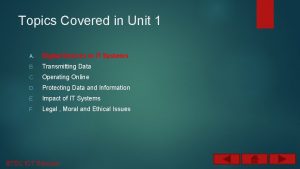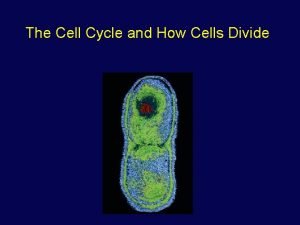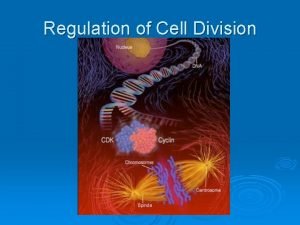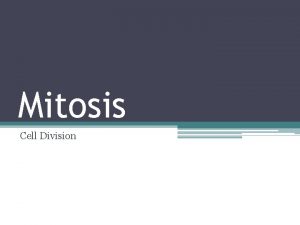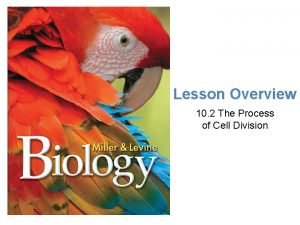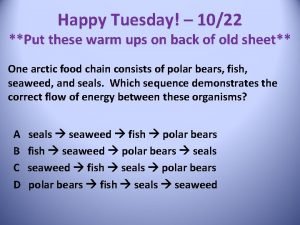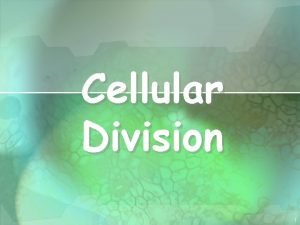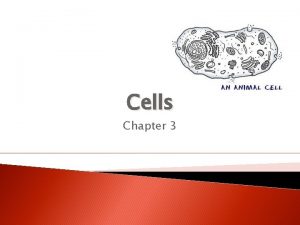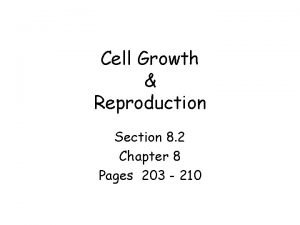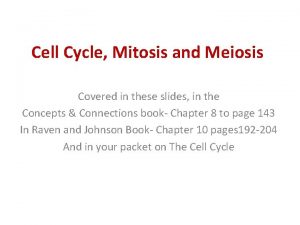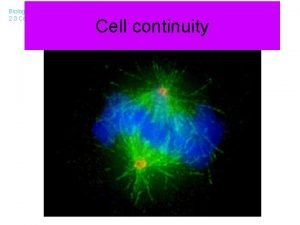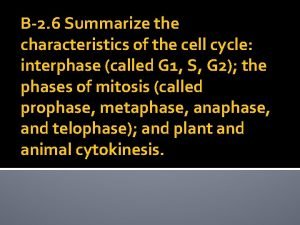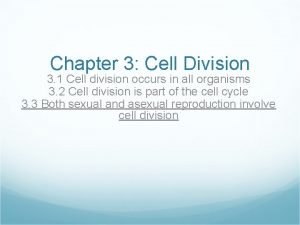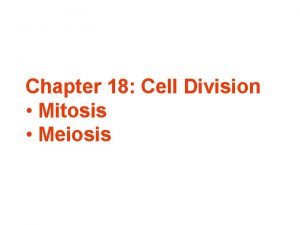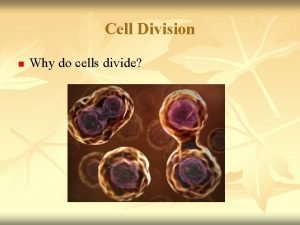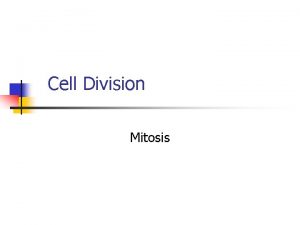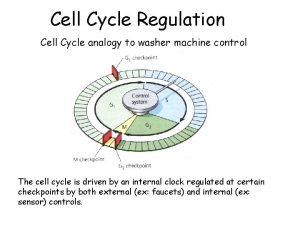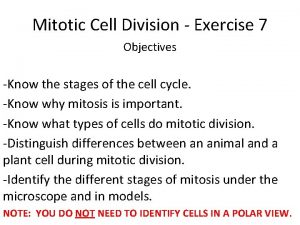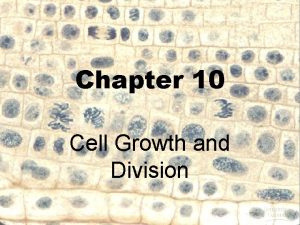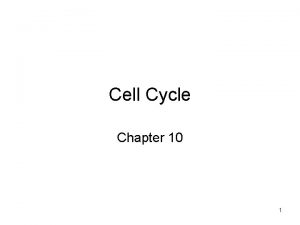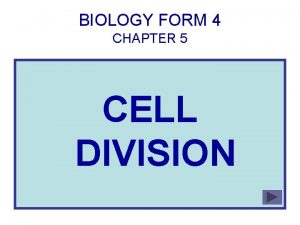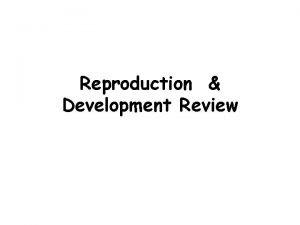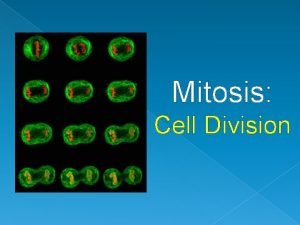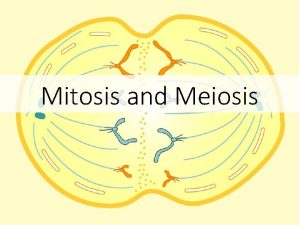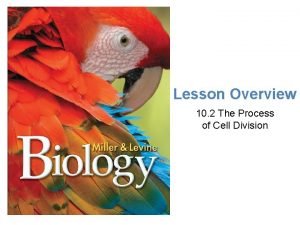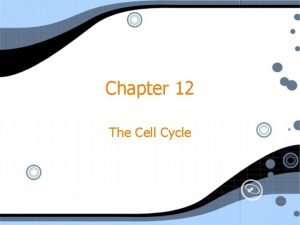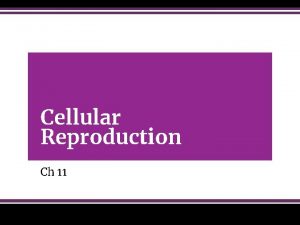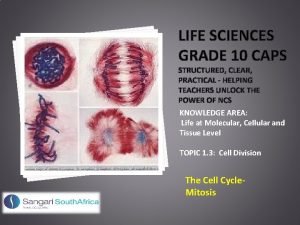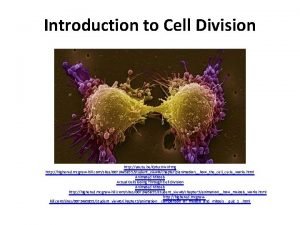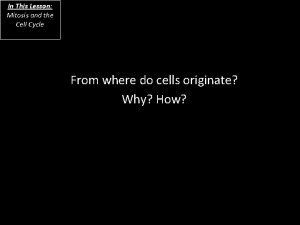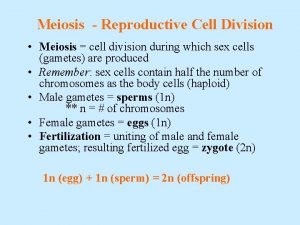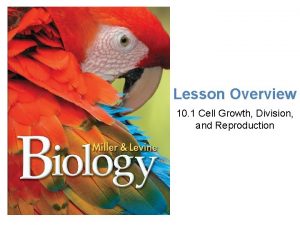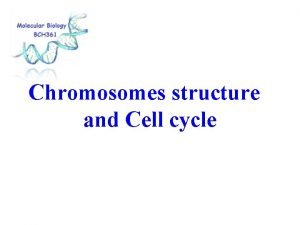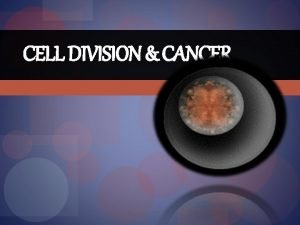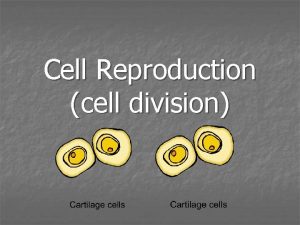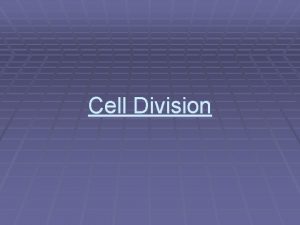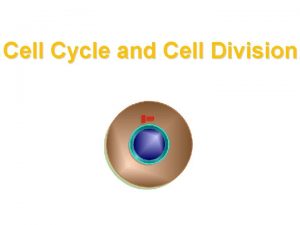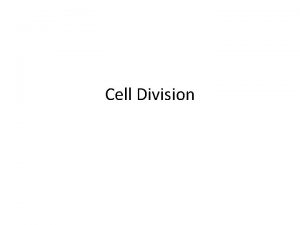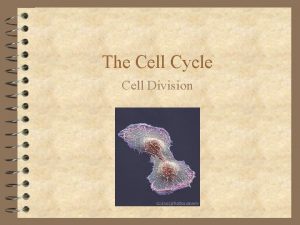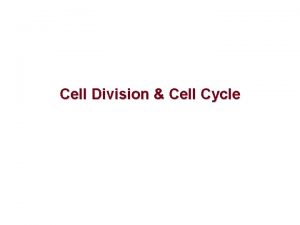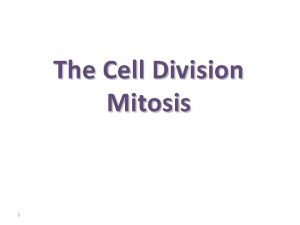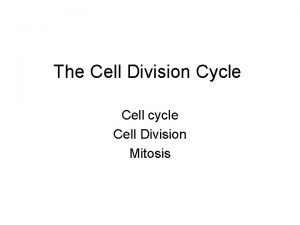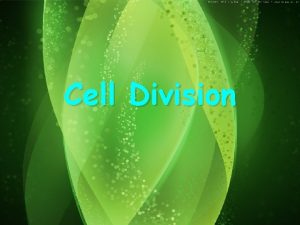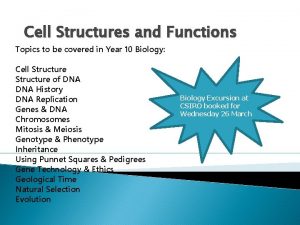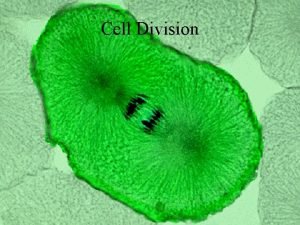TOPICS COVERED The Functions of Cell Division The






















































- Slides: 54


TOPICS COVERED • The Functions of Cell Division • The Cell Cycle • Mitosis – A Detailed Look

THE FUNCTIONS OF CELL DIVISION living organisms This is the only Cell division is vital for all _______ process cells that can create new ____. • Cell division always involves ____ two main processes: 1) The division of the nuclear ______ contents. 2) The division of the cytoplasmic _____ contents. 2 nuclei 2 cytoplasms

THE FUNCTIONS OF CELL DIVISION living organisms This is the only Cell division is vital for all _______ process cells that can create new ____. QUICK TASK #1 Based on these images, what functions do you think cell division serves for organisms?

reproduction THE FUNCTIONS OF CELL DIVISION Asexual reproduction for ___cellular uni 1) _______ organisms. 2) Prokaryotes (like bacteria) • _____ 3) as well as unicellular protists ______ (like paramecium) reproduce asexually by a type of cell division called binary fission ______. 4) 5) Paramecium Binary Fission PLAY E. g. Binary fission in bacteria.

reproduction THE FUNCTIONS OF CELL DIVISION Asexual reproduction for ___cellular uni 1) _______ organisms. Asexual reproduction for _____cellular multi 2) _______ organisms. 3) • Organisms like hydra _____ (an 4) underwater animal) undergo cell division to growths (buds) produce _______ from their bodies which fall off and eventually ______ become cloned offspring. 5) E. g. The budding of hydra. • This process is called budding _______.

reproduction THE FUNCTIONS OF CELL DIVISION Asexual reproduction for ___cellular uni 1) _______ organisms. Asexual reproduction for _____cellular multi 2) _______ organisms. 3) • _____ Autotomy is when an 4) organism performs a self-amputation of one of _______ its body parts. 5) starfish can • Some _______ E. g. Autotomy of arms in some starfish. autotomize their arms ____ which will undergo cell division to regenerate _____ into cloned offspring.

reproduction THE FUNCTIONS OF CELL DIVISION Asexual reproduction for ___cellular uni 1) _______ organisms. Asexual reproduction for _____cellular multi 2) _______ organisms. 3) cloned offspring 4) 5) cloned offspring runner E. g. Runners on a spider plant. E. g. Runner on a strawberry plant. • Some plants reproduce without seeds or spores through vegetative reproduction asexual ___________. • One method of doing this is to undergo cell division to runners which are extensions from the parent produce _______ plant that contain attached cloned offspring.

reproduction THE FUNCTIONS OF CELL DIVISION Asexual reproduction for ___cellular uni 1) _______ organisms. Asexual reproduction for _____cellular multi 2) _______ organisms. Sexual reproduction in _____cellular multi 3) ______ organisms. • In sexual reproduction, cell division 4) two reasons: is required for ____ 5) 1) to make gametes _______ like sperm _____ and eggs ____. 2) to allow the multiple divisions needed multicellular organism. to create a ______ Human Embryo Cell Division E. g. Spermatogenesis PLAY

reproduction THE FUNCTIONS OF CELL DIVISION Asexual reproduction for ___cellular uni 1) _______ organisms. Asexual reproduction for _____cellular multi 2) _______ organisms. Sexual reproduction in _____cellular multi 3) ______ organisms. • In sexual reproduction, cell division 4) two reasons: is required for ____ 5) 1) to make gametes _______ like sperm _____ and eggs ____. 2) to allow the multiple divisions needed multicellular organism. to create a ______ Real-time Fruit Fly Embryo Development E. g. Spermatogenesis PLAY

reproduction THE FUNCTIONS OF CELL DIVISION Asexual reproduction for ___cellular uni 1) _______ organisms. Asexual reproduction for _____cellular multi 2) _______ organisms. Sexual reproduction in _____cellular multi 3) ______ organisms. 4) Growth ______ and development ______ of a _____cellular organism. multi 5) size and • To reach adult ____ attain _______, adult structures many organisms have to continue to perform cell division even after all essential body parts have formed. E. g. Male human growth and development.

reproduction THE FUNCTIONS OF CELL DIVISION Asexual reproduction for ___cellular uni 1) _______ organisms. Asexual reproduction for _____cellular multi 2) _______ organisms. Sexual reproduction in _____cellular multi 3) ______ organisms. 4) Growth ______ and development ______ of a _____cellular organism. multi maintenance of a _____cellular _____ and ______ organism. multi 5) Repair QUICK TASK #2 Provide some examples of specific situations where cell division helps with repairing and maintaining your body.

reproduction THE FUNCTIONS OF CELL DIVISION Asexual reproduction for ___cellular uni 1) _______ organisms. Asexual reproduction for _____cellular multi 2) _______ organisms. Sexual reproduction in _____cellular multi 3) ______ organisms. 4) Growth ______ and development ______ of a _____cellular organism. multi maintenance of a _____cellular _____ and ______ organism. multi 5) Repair E. g. Cell division creates new bone cells to mend broken bones. E. g. Cell division creates new skin cells to repair skin damaged by a sunburn.

reproduction THE FUNCTIONS OF CELL DIVISION Asexual reproduction for ___cellular uni 1) _______ organisms. Asexual reproduction for _____cellular multi 2) _______ organisms. Sexual reproduction in _____cellular multi 3) ______ organisms. 4) Growth ______ and development ______ of a _____cellular organism. multi maintenance of a _____cellular _____ and ______ organism. multi 5) Repair E. g. Cell division needs to constantly replace red blood cells which only survive for ~120 days. E. g. It took one month for cell division to heal this damaged finger.

THE FUNCTIONS OF CELL DIVISION Except during the creation of gametes _______, cell division results in daughter cells that are genetically identical _______ to each _____ other and to cell the parent _____. • To create identical daughter cells, this type of cell division parent cell replication must involve DNA _______ and a process called mitosis ______ which involves the sorting ______ and daughter cells dividing _______ of the DNA into two equal halves. _____ cell cycle which we will now • Mitosis is a part of the ____ examine.

THE CELL CYCLE Cell Cycle: This represents the processes ____ that occur between one cell division and the ____ next cell division in a cell’s life. _____ three main stages and can be represented in • This involves _____ a pie chart: • The size of each pie is k ines cyto 1) Interphase 2) Mitosis 3) Cytokinesis mito sis interphase slice roughly represents how much time ____ a cell stays in each part of the cell cycle, but there are great variations depending on the type of cell.

THE CELL CYCLE INTERPHASE: The cell spends most of its life here performing its specialized functions and then prepares _________ for cell division when the time comes. is kines cyto Interphase is broken down into three _____ stages: 1) G 1 Phase (Gap 1): • The cell grows _____ after division to reach mito full size (it may double in size). sis G 1 interphase

THE CELL CYCLE INTERPHASE: The cell spends most of its life here performing its specialized functions and then prepares _________ for cell division when the time comes. is kines cyto Interphase is broken down into three _____ stages: 1) G 1 Phase (Gap 1): • The cell grows _____ after division to reach mito full size (it may double in size). G 1 sis • The cell performs its specialized function depending on what type _______ interphase of cell it is. bone cell neuron (brain cell) skeletal muscle cell heart muscle cell white blood cell

THE CELL CYCLE INTERPHASE: The cell spends most of its life here performing its specialized functions and then prepares _________ for cell division when the time comes. is ki nes cy to Interphase is broken down into three _____ stages: 1) G 1 Phase (Gap 1): • This is the longest ______ part of the cell mito cycle for most cells except for fast G 1 sis embryonic cells and cancer dividing _____ cells. interphase QUICK TASK #3 There are some cells that speed through G 1 very quickly and don’t spend much time, if any, performing specialized functions before they divide again. Can you guess what type of cells these would be?

THE CELL CYCLE INTERPHASE: The cell spends most of its life here performing its specialized functions and then prepares _________ for cell division when the time comes. is kines cyto Interphase is broken down into three _____ stages: 1) G 1 Phase (Gap 1): • Once organisms reach adulthood, divide mitos some of their cells will never _____ G 1 is again. These cells stop progressing through the cell cycle and go interphase G _________ 0 Phase (Gap Zero) where they will simply continue to perform their functions until they die. neuron (brain cell) heart muscle cell skeletal muscle cell

THE CELL CYCLE INTERPHASE: The cell spends most of its life here performing its specialized functions and then prepares _________ for cell division when the time comes. is kines cyto Interphase is broken down into three _____ stages: 2) S Phase (Synthesis): • The DNA is _____ ___ replicated creating two mito identical _______ copies of each G 1 sis chromosome. pair also • As well, the centriole ______ interphase duplicates to create ____ two pairs. _____ 1 centriole pair 1 set of chromosome s S 2 centriole pairs 2 sets of chromosome s

THE CELL CYCLE INTERPHASE: The cell spends most of its life here performing its specialized functions and then prepares _________ for cell division when the time comes. is ki nes cy to Interphase is broken down into three _____ stages: 3) G 2 Phase (Gap 2): prepares for mitosis by • The cell ____ mito growth of its undergoing rapid _______ sis cytoplasm. • The cell increases the synthesis of the proteins _______ needed to make the spindle fibers used in mitosis. ______ • The DNA is checked for replication errors that may have occurred ______ during DNA replication in S Phase. G 1 interphase G 2 QUICK TASK #4 S What occurs if replication errors are left undetected and Mutations! unfixed before mitosis?

THE CELL CYCLE INTERPHASE: The cell spends most of its life here performing its specialized functions and then prepares _________ for cell division when the time comes. is kines cyto Interphase is broken down into three _____ stages: 3) G 2 Phase (Gap 2): prepares for mitosis by • The cell ____ mito growth of its undergoing rapid _______ sis cytoplasm. • The cell increases the synthesis of the proteins _______ needed to make the spindle fibers used in mitosis. ______ • The DNA is checked for replication G 1 interphase G 2 S errors that may have occurred _________ during DNA replication in S Phase. This prevents mutations (changes in the DNA code) from being passed to daughter cells.

THE CELL CYCLE sorts and divides ______ the duplicated chromosomes MITOSIS: This process _____ identical sets of DNA so that each daughter cell into two ____ gets one set. Mitosis is needed to sort out these chromosomes. is ki nes cy to parent cell mito sis S Phase interphase G 2 correct sorting two identical sets of chromosomes in daughter G 1 � S However, mitosis isn’t always perfect…

THE CELL CYCLE sorts and divides ______ the duplicated chromosomes MITOSIS: This process _____ identical sets of DNA so that each daughter cell into two ____ gets one set. Mitosis is needed to sort out these chromosomes. is ki nes cy to parent cell mito sis S Phase interphase G 2 An error in mitosis has occurred. incorrect sorting two non-identical sets of chromosomes in daughter G 1 � S

THE CELL CYCLE sorts and divides ______ the duplicated chromosomes MITOSIS: This process _____ identical sets of DNA so that each daughter cell into two ____ gets one set. However, the events that occur between ____ prophase h p and metaphase _____ are a t e Prom important enough to create a fifth stage between these two called prometaphase ______. is ki nes cy to four main stages Mitosis is broken down into ____ and they can be represented by the Te lop P. M. A. T. which stands for… acronym _______ h a Ana phas se e G 1 Metaphase se a h interphase Prop G 2 S After mitosis divides the nuclear contents into two parts, it’s time to divide the

THE CELL CYCLE cytoplasm in half to CYTOKINESIS: The process that divides ______ the _____ separate daughter cells. create two ____ is kines cyto Animal Cells • In animal cells, a cleavage furrow _______ forms to constrict the cell membrane in the middle of the cell and divide it. Te lop ha Ana phas se e 1 Metaphase se a h interphase Pr op G 2 Sanddollar cytokinesis cleavage furrow PLAY G S

THE CELL CYCLE cytoplasm in half to CYTOKINESIS: The process that divides ______ the _____ separate daughter cells. create two ____ • Instead of making a cleavage furrow, a plant cell makes a cell plate in the ____ middle of the cell plate is kines cyto Plant Cells • In plant cells, the cell wall makes _______ cytokinesis more challenging. Te lop ha Ana phas se e 1 Metaphase se a h interphase Pr op G 2 G S

THE CELL CYCLE cytoplasm in half to CYTOKINESIS: The process that divides ______ the _____ separate daughter cells. create two ____ is ki nes cy to Plant Cells • The cell plate is made up of vesicles ______ which contain the material needed to wall build the cell _______. fuse at • The vesicles ____ the midline of the cell to create a new cell wall which completely separates ____ the two daughter cells. Te lop ha Ana phas se e 1 Metaphase se a h interphase Prop G 2 G S

MITOSIS – A DETAILED LOOK G 1 Interphase • In this example, we will examine a cell chromosomes (red, blue and containing 3_______ green) in the initial parent cell. G 2 Interphase • After S Phase, each chromosome has undergone DNA replication. There are now 3 duplicated chromosomes ____________. • At this point, the DNA has _______ not condensed yet so it is still ____ long and ____. thin This long _____ form of DNA is called _____. thread-like chromatin

MITOSIS – A DETAILED LOOK G 2 Interphase

MITOSIS – A DETAILED LOOK G 2 Interphase • The two identical sides of each duplicated • chromosome are called ________. sister chromatids The two sister chromatids are connected _____ together at a region of the chromosome called the centromere _____. • The centromere is where • microtubules protein structures called ______ kinetochores assemble on either side of the sister chromatids. The kinetochores are the attachment for sites of ___________ which pull ___ the kinetochores microtubules sister chromatids apart. sister chromatid s centromer e

MITOSIS – A DETAILED LOOK G 2 Interphase • The two identical sides of each duplicated • chromosome are called ________. sister chromatids The two sister chromatids are connected _____ together at a region of the chromosome called the centromere _____. spindle fibers / microtubules • Microtubules ______ are protein filaments that serve various different functions within a cell. When they are used in mitosis or meiosis, they can be specifically referred to spindle fibers as ______. kinetochores sister chromatid s centromer e

MITOSIS – A DETAILED LOOK G 2 Interphase • The centriole ______ pair along with the _______ proteins that surround it form the centrosome _____ whic organizing h is the organelle responsible for _____ the microtubules ______. Centrosomes are only found in ______ animal cells. centrosome s replicated in S Phase to • Along with the DNA, the centrosome is _____ produce the two centrosomes you see in G 2.

MITOSIS Pro. Telophase Anaphase Metaphase metaphase Prophase MITOSIS – A DETAILED LOOK PROPHASE nuclear membrane • The centrosomes begin to migrate _______ to opposite poles _______. • ______ Spindle fibers begin to form between the two centrosomes. • The nuclear ________ membrane begins to dissolve QUICK TASK #5 Why do you think the nuclear membrane needs to dissolve completely?

MITOSIS Pro. Telophase Anaphase Metaphase metaphase Prophase MITOSIS – A DETAILED LOOK PROPHASE nuclear membrane • The centrosomes begin to migrate _______ to opposite poles _______. • ______ Spindle fibers begin to form between the two centrosomes. nucleolus • The nuclear ________ membrane begins to dissolve which _____ frees the chromosomes to be sorted and divided in later stages of mitosis. condense and • The chromatin begins to ____ visible become shorter ______ , thicker ______ and ______. • The nucleolus ____ begins to disappear.

MITOSIS Pro. Telophase Anaphase Metaphase metaphase Prophase MITOSIS – A DETAILED LOOK PROMETAPHASE QUICK TASK #6 Compare prometaphase to prophase. What changes have

MITOSIS Pro. Telophase Anaphase Metaphase metaphase Prophase MITOSIS – A DETAILED LOOK PROMETAPHASE equatorial plate • The nuclear membrane is ______ almost completely dissolved which allows fibers access the spindle ______ to the duplicated chromosomes. kinetochore spindle fibers The nucleolus ____ has disappeared. • nucleolus • Kinetochore _____ spindle fibers reach through the dissolving nuclear membrane and attach to the ______ kinetochores of each ______ duplicated chromosome. These spindle position the duplicated fibers begin to _______ chromosomes along the midline of the cell equatorial (or metaphase) plate called the _____.

MITOSIS Pro. Telophase Anaphase Metaphase metaphase Prophase MITOSIS – A DETAILED LOOK PROMETAPHASE equatorial plate • The nuclear membrane is ______ almost completely dissolved which allows fibers access the spindle ______ to the duplicated chromosomes. astral spindle fibers kinetochore spindle fibers polar spindle fibers • Polar ____ spindle fibers from opposite poles • reach the midline and push against one extend the distance between another to ______ the two centrosomes. Astral spindle fibers help anchor ______ the centrosomes at opposite poles of the cell.

MITOSIS Pro. Telophase Anaphase Metaphase metaphase Prophase MITOSIS – A DETAILED LOOK PROMETAPHASE equatorial plate • The nuclear membrane is ______ almost completely dissolved which allows fibers access the spindle ______ to the duplicated chromosomes. astral spindle fibers kinetochore spindle fibers polar spindle fibers • All of the different types of spindle fibers help form a network of fibers called the spindle apparatus (or _______). mitotic spindle ________

MITOSIS Pro. Telophase Anaphase Metaphase metaphase Prophase MITOSIS – A DETAILED LOOK METAPHASE QUICK TASK #7 Compare metaphase to pro-metaphase. What changes have

MITOSIS Pro. Telophase Anaphase Metaphase metaphase Prophase MITOSIS – A DETAILED LOOK METAPHASE • The centrosomes are ____ fully migrated to opposite poles. • The spindle apparatus is completely _____ formed. fully dissolved. • The nuclear membrane is ____ up the • The spindle fibers have lined _______ duplicated chromosomes along the equatorial plate so that each sister _______ chromatid of a duplicated chromosome faces opposite _______ poles.

MITOSIS Pro. Telophase Anaphase Metaphase metaphase Prophase MITOSIS – A DETAILED LOOK METAPHASE • The centrosomes are ____ fully migrated to opposite poles. • The spindle apparatus is completely _____ formed. alignment at this stage helps to • Correct _____ ensure that each new daughter cell will receive one sister chromatid from each duplicated chromosome when the sister chromatids are separated.

MITOSIS Pro. Telophase Anaphase Metaphase metaphase Prophase MITOSIS – A DETAILED LOOK METAPHASE • At this stage, the chromosomes are thick ____, _____ short and at their most condensed _____, hence the chromosomes are at their most easily observable state. sister chromatid centromer e

MITOSIS Pro. Telophase Anaphase Metaphase metaphase Prophase MITOSIS – A DETAILED LOOK ANAPHASE QUICK TASK #8 Compare anaphase to metaphase. What changes have occurred?

MITOSIS Pro. Telophase Anaphase Metaphase metaphase Prophase MITOSIS – A DETAILED LOOK ANAPHASE • Each chromatid becomes its own ______ chromosome once separation has occurred. shorten • The kinetochore _____ spindle fibers _______ and ____ pull the attached sister chromatids apart at the _____ centromere towards opposite poles. • The polar ____ spindle fibers push against each other to elongate _______ the cell and further separate the sister chromatids.

MITOSIS Pro. Telophase Anaphase Metaphase metaphase Prophase MITOSIS – A DETAILED LOOK TELOPHASE QUICK TASK #9 Compare telophase to anaphase. What changes have

MITOSIS Pro. Telophase Anaphase Metaphase metaphase Prophase MITOSIS – A DETAILED LOOK TELOPHASE • This phase is essentially the reverse ______ of prophase. • The spindle apparatus begins to disassemble _____. • The chromosomes become ____ long and thin decondensing and reverting ___ by ______ chromatin structure. back to their _____ membrane begins to reform • A nuclear ________ around each set of chromosomes. • The nucleolus ____ reappears in each nucleus.

MITOSIS Pro. Telophase Anaphase Metaphase metaphase Prophase MITOSIS – A DETAILED LOOK TELOPHASE cleavag e furrow (or ____ cell plate in • A cleavage _______ plant cells) begins to form which signals the beginning of _____ cytokinesis which will separate the two new daughter cells.

MITOSIS Pro. Telophase Anaphase Metaphase metaphase Prophase MITOSIS – A DETAILED LOOK Real cells are harder to identify! prophase metaphase prometaphase telophase interphase anaphase How many did you get correct? Identify cells A-F as interphase, prometaphase, anaphase or telophase. ACTIVITY #1

MITOSIS Pro. Telophase Anaphase Metaphase metaphase Prophase MITOSIS – A DETAILED LOOK prophase A anaphase B telophase C interphase D metaphase E How many did you get correct? ACTIVITY #2 Identify cells A-E as interphase, prophase, metaphase, anaphase or telophase. (There’s no prometaphase example in this

MITOSIS Pro. Telophase Anaphase Metaphase metaphase Prophase MITOSIS – A DETAILED LOOK Mitosis (Overview) PLAY The Cell Cycle and Mitosis (Detailed) PLAY

The End!

Created by Anh-Thi Tang – Tangstar Science Copyright © February 2015 Anh-Thi Tang (a. k. a. Tangstar Science) All rights reserved by author. This document is for personal classroom use only. This entire document, or any parts within, may not be electronically distributed or posted to any website including teacher or classroom blogs or websites. http: //www. teacherspayteachers. com/Store/Tangstar-Science
 What topics will be covered in this unit
What topics will be covered in this unit Section 10-2 cell division
Section 10-2 cell division Cell cycle and cell division
Cell cycle and cell division Cell cycle chart
Cell cycle chart Cell division functions
Cell division functions Division and classification
Division and classification Short division vs long division
Short division vs long division How to synthetic division
How to synthetic division Whats a dividend in math
Whats a dividend in math Long division objectives
Long division objectives Pmat
Pmat Frequency of cell division
Frequency of cell division Does crossing over occur in both mitosis and meiosis
Does crossing over occur in both mitosis and meiosis Interphase of cell cycle
Interphase of cell cycle About anaphase
About anaphase Cell division acronym
Cell division acronym What is early prophase
What is early prophase When cell division does not occur in the usual pattern a(n)
When cell division does not occur in the usual pattern a(n) Section 8-2 cell division
Section 8-2 cell division Sexual and asexual reproduction
Sexual and asexual reproduction Mitosis and meiosis
Mitosis and meiosis Cell furrow method
Cell furrow method Cleavage furrow in cell division
Cleavage furrow in cell division Cell continuity definition
Cell continuity definition Prophase 1
Prophase 1 Asexual reproduction cell division
Asexual reproduction cell division Parts of chromosomes
Parts of chromosomes Meiosis
Meiosis Unicellular cell division
Unicellular cell division Stage 2 of mitosis
Stage 2 of mitosis Cell division
Cell division Cell division vocabulary
Cell division vocabulary Cell cycle analogy
Cell cycle analogy Cell division exercise
Cell division exercise Mitosis pipe cleaner activity
Mitosis pipe cleaner activity Section 10-2 cell division answer key
Section 10-2 cell division answer key Cell division
Cell division Cell cycle mind map
Cell cycle mind map What process is this
What process is this Cell division
Cell division Cell division
Cell division Mitosis in whitefish and onion roots
Mitosis in whitefish and onion roots Mitosis bingo
Mitosis bingo Gap 1 phase
Gap 1 phase What happends during telophase
What happends during telophase What phase is this cell in
What phase is this cell in Cell division
Cell division Cell division
Cell division Uncontrolled cell division
Uncontrolled cell division What kind of cells does mitosis make?
What kind of cells does mitosis make? Interesting facts about mitosis
Interesting facts about mitosis Cell division
Cell division Reproductive cell division
Reproductive cell division Cell growth division and reproduction
Cell growth division and reproduction Cell division in multicellular organisms
Cell division in multicellular organisms
